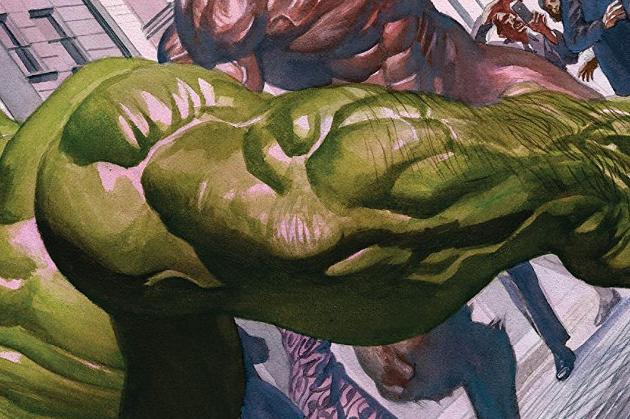Immortal Hulk #27 Review
Writer: Al Ewing
Penciller: Joe Bennett
Inkers: Ruy José, Belardino Brabo, Marc Deering & Sean Parsons
Colourist: Paul Mounts
Letterer: Cory Petit
Publisher: Marvel Comics
Immortal Hulk #27 portrays a simple set-piece battle between the Hulk and the forces of Roxxon. At the same time, Dario Agger is meeting with his board.
The tension between these two story threads creates pure magic.
First, on a purely textual level: Agger's meeting gives him exactly the platform he needs to make some thesis statements. Al Ewing sets him up as a foil for the Hulk, and he does it masterfully by bringing the two characters very close together.
Agger is like the Hulk in that he sees an imminent and calamitous end to late-stage capitalism. They both agree the world is going to Hell.
It's just that the Minotaur has invested heavily in handbaskets.
Next, the issue enjoys a formal structure that comes to life as a brilliant union of script and art. It starts with a six-panel grid that moves along three story threads in smooth parallel. There's Agger's board meeting, the Hulk's combat prep at Shadow Base, and a thread showing the unsuspecting Roxxon Berserkers who are waiting for him.
When the Hulk strikes, the second and third threads collapse together to open up big beautiful double-spread action while Agger's meeting continues along the top.
There are some feints in the dialogue about these Berserkers being fearsome matches for the Hulk -- but c'moooon. Genuine Hulk™ vs. Store-Brand Hulk? That only ever ends one way.
Joe Bennett has a blast taking us to that inevitable victory. This Hulk may be vicious and amoral and broken-in-the-head, but he enjoys a good smashing. And thanks to the art, readers can, too.
The inkers keep up admirably, layering tremendous detail into even the most dynamic panels. Paul Mounts takes the colours on an odyssey, moving from split palettes in the beginning to a unified night-time look to a golden dawn on the final page.
And the art team continues to play with interesting structural ideas throughout the book. Once the smashing is in full swing, they employ the title's now-familiar visual logic: The Hulk unleashed is portrayed in savage, jumbled, angular panels. This contrasts with the grid, but the split is not taken for granted. In the final act, violence intrudes into the rectangular world of Agger's story and it's all the more shocking for its tight confines.
Immortal Hulk #27 is a natural evolution of the story launched in the previous issue. It maintains and extends the intellectual aspect of the Hulk/Roxxon conflict while also dialling up the smash in a big way. There's even space for a few intriguing refinements in the Banner/Hulk relationship. Whether it goes quiet or loud or makes an effective compromise between the two, as it does here, Immortal Hulk is always worth checking out.
Penciller: Joe Bennett
Inkers: Ruy José, Belardino Brabo, Marc Deering & Sean Parsons
Colourist: Paul Mounts
Letterer: Cory Petit
Publisher: Marvel Comics
Immortal Hulk #27 portrays a simple set-piece battle between the Hulk and the forces of Roxxon. At the same time, Dario Agger is meeting with his board.
The tension between these two story threads creates pure magic.
First, on a purely textual level: Agger's meeting gives him exactly the platform he needs to make some thesis statements. Al Ewing sets him up as a foil for the Hulk, and he does it masterfully by bringing the two characters very close together.
Agger is like the Hulk in that he sees an imminent and calamitous end to late-stage capitalism. They both agree the world is going to Hell.
It's just that the Minotaur has invested heavily in handbaskets.
Next, the issue enjoys a formal structure that comes to life as a brilliant union of script and art. It starts with a six-panel grid that moves along three story threads in smooth parallel. There's Agger's board meeting, the Hulk's combat prep at Shadow Base, and a thread showing the unsuspecting Roxxon Berserkers who are waiting for him.
When the Hulk strikes, the second and third threads collapse together to open up big beautiful double-spread action while Agger's meeting continues along the top.
There are some feints in the dialogue about these Berserkers being fearsome matches for the Hulk -- but c'moooon. Genuine Hulk™ vs. Store-Brand Hulk? That only ever ends one way.
Joe Bennett has a blast taking us to that inevitable victory. This Hulk may be vicious and amoral and broken-in-the-head, but he enjoys a good smashing. And thanks to the art, readers can, too.
The inkers keep up admirably, layering tremendous detail into even the most dynamic panels. Paul Mounts takes the colours on an odyssey, moving from split palettes in the beginning to a unified night-time look to a golden dawn on the final page.
And the art team continues to play with interesting structural ideas throughout the book. Once the smashing is in full swing, they employ the title's now-familiar visual logic: The Hulk unleashed is portrayed in savage, jumbled, angular panels. This contrasts with the grid, but the split is not taken for granted. In the final act, violence intrudes into the rectangular world of Agger's story and it's all the more shocking for its tight confines.
Immortal Hulk #27 is a natural evolution of the story launched in the previous issue. It maintains and extends the intellectual aspect of the Hulk/Roxxon conflict while also dialling up the smash in a big way. There's even space for a few intriguing refinements in the Banner/Hulk relationship. Whether it goes quiet or loud or makes an effective compromise between the two, as it does here, Immortal Hulk is always worth checking out.






Comments